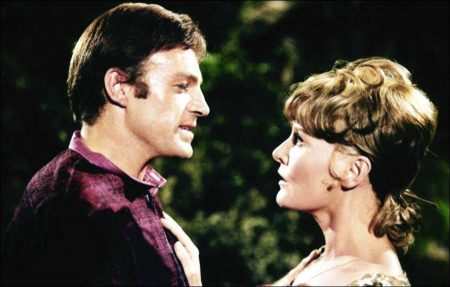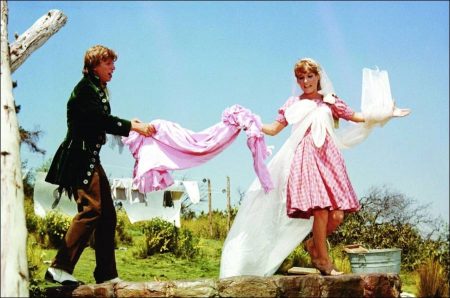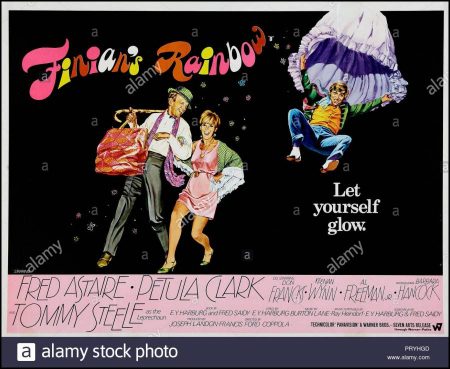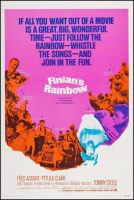Taglines: Let yourself grow.
Finian’s Rainbow movie storyline. Of Glocca Morra, Ireland, Finian McLongeran, who has his own unique belief system of Irish legends, uproots himself and his adult daughter, Sharon McLonergan, and heads for the mythical land of Rainbow Valley, Missitucky, USA where he believes he will become rich. One of those beliefs is that burying a crock of gold in Rainbow Valley will make it multiply, due to the power of rainbows and the Valley’s close proximity to Fort Knox.
Finian considers that he “borrowed” the crock of gold he has from the leprechauns of Glocca Morra, which he plans to return once he makes his fortune. Little does he know that in taking the gold, the leprechauns can no longer make wishes come true and are slowly turning mortal. One of those leprechauns, Og, has come to retrieve the crock of gold to save himself and his fellow leprechauns.
Finian and Sharon’s arrival in Rainbow Valley coincides with the return of the Valley’s prodigal son, Woody Mahoney, who has come to repay back taxes before his land is auctioned off. Woody’s sister, Susan Mahoney, is referred to by most Susan the Silent, as she has never spoken and communicates primarily through dance. In helping the Mahoneys repay those taxes, Finian only asks for a small parcel of that land for him and Sharon, and mostly for a place to bury the crock of gold.
With the rest of the land, Woody and his friend, Howard, a research botanist, plan to revolutionize the tobacco industry by growing the first ever mentholated tobacco plants, which is a little more difficult to accomplish than they initially believe. Much like Finian, Woody plans on getting rich the easy way, in Woody’s case off the hard work of Howard.
Regardless of Sharon’s dislike of what Woody is doing by being what she considers a schemer, the two fall in love. Finian’s assistance of Woody in keeping the land irks bigoted Senator Billboard Rawkins, who has been trying to buy up as much land in the Valley as possible. Complications ensue for all involved because of the crock of gold, even though most have not seen it or even know it exists for real.
Finian’s Rainbow is a 1968 musical fantasy film directed by Francis Ford Coppola and starring Fred Astaire and Petula Clark. The screenplay by E.Y. Harburg and Fred Saidy is based on their 1947 stage musical of the same name. An international co-production of Ireland and the United States, the film follows an Irishman and his daughter who steal a leprechaun’s magic pot of gold and emigrate to the U.S., where they become involved in a dispute between rural landowners and a greedy, racist U.S. Senator. The film was nominated for several Academy Awards, Golden Globe Awards, and a Writers Guild of America Award.
Film Review for Finian’s Rainbow
“Finian’s Rainbow” is the best of the recent roadshow musicals, perhaps because it’s the first to cope successfully with the longer roadshow form. The best musicals of the past (Astaire and Rogers in the 1930s, Gene Kelly’s and Stanley Donen’s productions in the 1950s) were rather modest in length and cost. They depended on charm and the great talents of their performers.
Since “The Sound of Music,” unhappily, musicals have been locked into the reserved-seat format. That, in turn, apparently means they have to be long, expensive, weighed down with unnecessary production values and filled with pretension. It was a gloomy sight to see the great songs and performances of “Camelot” trying to get out from beneath the dead weight of its expensive, unnecessary, distracting sets and costumes.
Movies are a faster medium than the stage. They don’t have entrances, exits, curtains, scene changes. Yet recent film “versions” actually tend to be longer than Broadway productions, and the second half is often an ordeal. Movie musicals shouldn’t be much more than two hours long, I think.
“Finian’s Rainbow” is an exception. It gives you that same wonderful sense you got from “Swing Time” or “Singin’ in the Rain” or any of the great musicals: that it knows exactly where it’s going, and is getting there as quickly and with as much fun as possible. Remarkably, because it is only Francis Ford Coppola’s second film, it is the best-directed musical since “West Side Story.” It is also enchanting, and that’s a word I don’t get to use much.
A lot of the fine things in the film come from Fred Astaire, who possibly danced better 30 years ago but has never achieved a better characterization. In most of the Astaire musicals we remember, he was really playing himself, and the plot didn’t make much of an effort to conceal that. This time he plays arthritic, wizened, wise Finian McLonergan (with some songs and dances the original stage Finian didn’t have). And it is a remarkable performance.
It is so good, I suspect, because Astaire was willing to play it as the screenplay demands. He could have rested on his laurels and his millions easily enough, turning out a TV special now and then, but instead he created this warm old man, Finian, and played him wrinkles and all. Astaire is pushing 70, after all, and no effort was made to make him look younger with common tricks of lighting, makeup and photography. That would have been unnecessary: He has a natural youthfulness. I particularly want to make this point because of the cruel remarks on Astaire’s appearance in the New York Times review by Renata Adler. She is mistaken.
All the same, this isn’t Astaire’s movie. One of its strengths is that a lot of characters are involved, and their roles are well balanced. The story is familiar: Finian and his daughter (Petula Clark) journey to America with a pot of gold stolen from a leprechaun (Tommy Steele). They pitch up in Rainbow Valley, a rural co-operative near Fort Knox. It is inhabited by black and white farmers who raise tobacco, by a redneck sheriff and by a Southern senator (Keenan Wynn) who is even more stereotyped than Strom Thurmond. There is an intrigue involving the back taxes on the co-op, a couple of romances, race relations, and the pot of gold.
Petula Clark is a surprise. I knew she could sing, but I didn’t expect much more. She is a fresh addition to the movies: a handsome profile, a bright personality, and a singing voice as unique in its own way as Streisand’s. Tommy Steele, as always, is a shade overdone, but perhaps a leprechaun should be a shade overdone.
Al Freeman Jr., who plays an earnest young Negro botanist, has a hilarious moment as he brings the senator a bromo with the official darky shuffle. Barbara Hancock, an accomplished dancer, is fetching as Susan the Silent. Don Francks, as Petula’s boyfriend, is clean-cut and pleasant, alas. And after the racist senator (Wynn) is magically turned black, there’s a bravura scene. He joins up with one of the most improbable gospel quartets ever assembled.
The movie’s message is a sort of subliminal plea for racial understanding but not much is made of it. Perhaps that’s just as well. “Camelot” got mired in its involved philosophy, and “My Fair Lady” succeeded because it dumped most of Shaw’s preaching.
For the rest, “Finian’s Rainbow” is a marvelous evening right up to its last shot of Astaire walking away down a country road. Unfortunately, the management of the Bismarck turned on the house lights before Astaire was finished walking; for that, I would gladly turn them into little green toads.
Finian’s Rainbow (1968)
Directed by: Francis Ford Coppola
Starring: Fred Astaire, Petula Clark, Don Francks, Keenan Wynn, Al Freeman, Jr., Barbara Hancock, Tommy Steele, Wright King, Ronald Colby, Dolph Sweet, Louil Silas, Brenda Arnau, Charles Carter
Screenplay by: E.Y. Harburg, Fred Saidy
Production Design by: Hilyard M. Brown
Cinematography by: Philip H. Lathrop
Film Editing by: Melvin Shapiro
Costume Design by: Dorothy Jeakins
Set Decoration by: Phil Abramson, William L. Kuehl
Music by: Burton Lane
MPAA Rating: None.
Distributed by: Warner Bros. Pictures, Seven Arts
Release Date: October 9, 1968
Visits: 82



